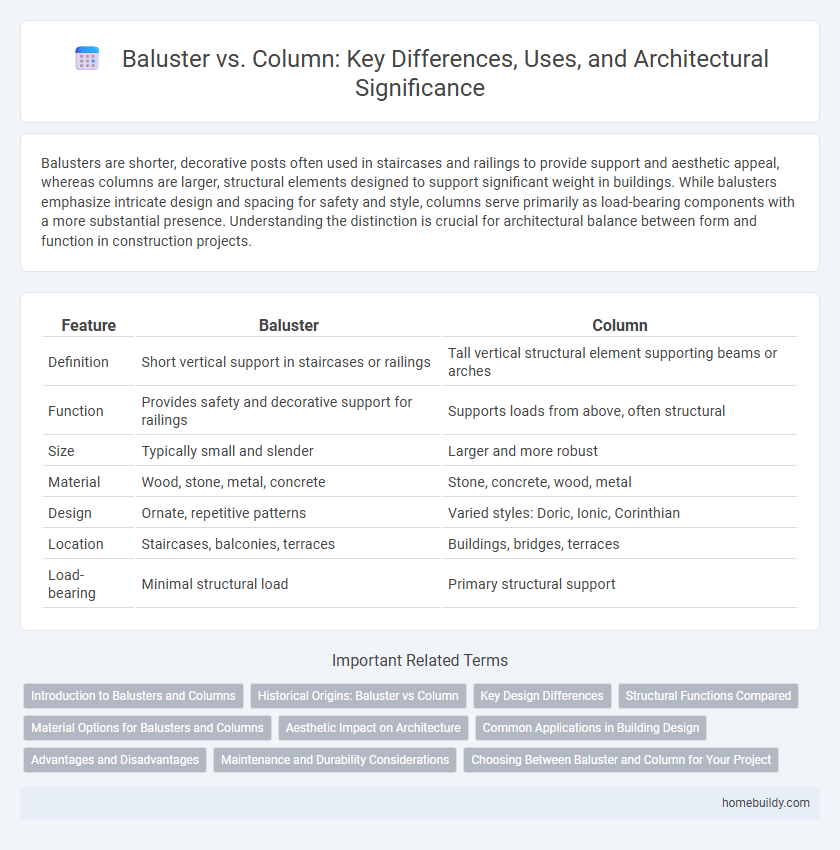Balusters are shorter, decorative posts often used in staircases and railings to provide support and aesthetic appeal, whereas columns are larger, structural elements designed to support significant weight in buildings. While balusters emphasize intricate design and spacing for safety and style, columns serve primarily as load-bearing components with a more substantial presence. Understanding the distinction is crucial for architectural balance between form and function in construction projects.
Table of Comparison
| Feature | Baluster | Column |
|---|---|---|
| Definition | Short vertical support in staircases or railings | Tall vertical structural element supporting beams or arches |
| Function | Provides safety and decorative support for railings | Supports loads from above, often structural |
| Size | Typically small and slender | Larger and more robust |
| Material | Wood, stone, metal, concrete | Stone, concrete, wood, metal |
| Design | Ornate, repetitive patterns | Varied styles: Doric, Ionic, Corinthian |
| Location | Staircases, balconies, terraces | Buildings, bridges, terraces |
| Load-bearing | Minimal structural load | Primary structural support |
Introduction to Balusters and Columns
Balusters are short, vertical posts that support a railing, commonly used in staircases, balconies, and terraces, often featuring ornate designs for both structural support and decorative appeal. Columns, larger and more robust, serve as primary load-bearing elements in architecture, supporting beams or arches and often forming key structural components of buildings. While balusters emphasize aesthetics and safety in railings, columns focus on strength and integrity in architectural frameworks.
Historical Origins: Baluster vs Column
Balusters trace their origins to Renaissance architecture, evolving as decorative and structural elements that support railings and balconies with intricate shapes, often crafted from wood, stone, or iron. Columns, rooted in ancient civilizations like Greece and Rome, served as primary load-bearing structures characterized by standardized orders such as Doric, Ionic, and Corinthian, emphasizing grandeur and monumental scale. The historical evolution of balusters reflects a shift towards ornamental detail in smaller architectural components, whereas columns represent foundational architectural principles in classical construction.
Key Design Differences
Balusters are typically slender, shorter vertical posts used primarily in staircases and railings to provide support and safety, while columns are larger, structural elements designed to bear weight and support buildings or architectural features. Balusters often feature decorative profiles and are spaced closely, emphasizing ornamental detail and safety. Columns emphasize strength and stability with varied classical or modern styles, serving both functional and aesthetic roles in architecture.
Structural Functions Compared
Balusters primarily serve as vertical supports in railings, providing safety and aesthetic appeal while bearing minimal structural load. Columns, conversely, are designed to support significant weight, transferring loads from roofs or upper floors down to foundations. The key structural difference lies in columns being load-bearing elements, whereas balusters function mainly as guardrails and decorative components with limited load capacity.
Material Options for Balusters and Columns
Balusters commonly come in materials such as wood, wrought iron, glass, and fiberglass, offering versatility in design and finish options, while columns are typically constructed from heavier materials like stone, concrete, or architectural-grade fiberglass to support more structural loads. Wood balusters provide a classic aesthetic and easy customization, whereas iron balusters add intricate detail and durability for outdoor use. Columns made of cast stone or concrete excel in load-bearing capacity, making them ideal for entryways or porches where both strength and appearance are important.
Aesthetic Impact on Architecture
Balusters create intricate rhythmic patterns that enhance the visual appeal of staircases and balconies, adding a delicate, ornamental touch to architectural designs. Columns, being larger and more structural, offer a sense of grandeur and solidity, often serving as focal points that emphasize classical or monumental styles. The choice between balusters and columns directly influences the building's aesthetic by balancing elegance and structural prominence.
Common Applications in Building Design
Balusters are primarily used as vertical support elements in staircases, balconies, and railings, offering both safety and aesthetic appeal with their slim, closely spaced profile. Columns serve a more structural role, bearing significant loads and often appearing in entryways, porches, and large open spaces to support beams or arches. While balusters enhance the visual intricacy and safety of horizontal barriers, columns provide foundational support and architectural grandeur in building design.
Advantages and Disadvantages
Balusters provide a more decorative and intricate design ideal for stair railings, offering enhanced safety by preventing falls, whereas columns serve primarily as structural supports capable of bearing heavy loads. Balusters are typically smaller, allowing for flexible spacing and greater aesthetic variety, but they may lack the load-bearing strength of columns, which limits their use in purely decorative contexts. Columns offer durability and strength advantages but can be bulky and less adaptable to intricate design patterns compared to balusters.
Maintenance and Durability Considerations
Balusters typically require more frequent maintenance due to their smaller size and intricate designs, which can accumulate dirt and suffer damage more easily compared to columns. Columns are often constructed from more durable materials such as stone or reinforced concrete, offering greater resistance to weathering and structural stress over time. Proper sealing and periodic inspections are essential for balusters to prevent deterioration, while columns usually demand less frequent upkeep but may require specialized repairs if structural integrity is compromised.
Choosing Between Baluster and Column for Your Project
Selecting between a baluster and a column depends on the structural and aesthetic requirements of your project, with balusters typically used for railing support and decorative detailing, while columns serve as primary load-bearing elements. Balusters are ideal for staircases, balconies, and porches, offering slender profiles and spacing versatility, whereas columns provide substantial strength and architectural prominence for entrances, porticos, or large open spaces. Consider material, scale, and design intent when deciding, as balusters enhance safety and style in small-scale applications, while columns define grandeur and structural integrity.
Baluster vs Column Infographic

 homebuildy.com
homebuildy.com